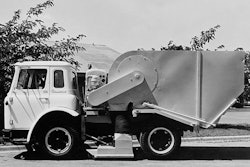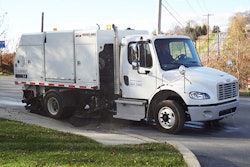
Controlling stormwater runoff isn't an easy feat. High levels of organic and inorganic contaminants in street dust represent a source of dual risk to stormwater and air quality. However, if localities focus their approach to target "hot spots" or areas of high concern with high-efficiency street sweeping, pollutants have been found to decrease in such circumstances.
The Equipment
Newer sweepers are more effective at street dirt pick-up than ever before. Most street sweepers fall into one of three categories; mechanical, vacuum and regenerative air. Mechanical street sweepers are effective at picking up wet vegetation, gravel and coarse sand, but are less efficient at removing fine particles. Vacuum street sweepers have gained popularity because of their ability to remove fine dust more effectively than their mechanical counterparts. Vacuum sweepers are comparable to a household vacuum—they suck in air with a fan, collect dust and debris and then exhaust the air.
Regenerative air sweepers have the ability to clean a larger path than vacuum sweepers, remove smaller debris and The closed-loop regenerative air system uses the force of a high velocity controlled jet of air created by the powerful blower wheel.TYMCO
The closed-loop regenerative air system uses the force of a high velocity controlled jet of air created by the powerful blower wheel.TYMCO
“Regenerative air sweepers were invented in the mid-1960’s by TYMCO late founder B.W. Young,” said Tom Rokas, Inside Sales with TYMCO. “Similar to a vacuum type sweeper, dirt and debris are sucked into a hopper, where the large volume of the hopper causes the heavier material to fall, while a screen traps lighter material such as leaves. Rather than being exhausted, the air is cleaned by a dust separator and then returned to the blast orifice of the pick-up head in a closed loop cycle.”
These sweepers utilize a blast and suction effect, which has proven more effective in cleaning those hard to reach places that a vacuum or mechanical sweeper cannot get. The machine's blast force is able to reach and clean the entire area the sweeper is trying to cover.
“Regenerative air sweepers are better at picking up smaller particles than mechanical and vacuum sweepers because the air blast and suction action of the pick-up head, which covers the entire width of the sweeper, reaches areas not accessible to cylindrical brooms,” said Rokas.
Street Sweeping Removes Contaminants
Debris and contaminants from streets are the most readily controllable sources of urban stormwater pollution. The Environmental Protection Agency (EPA) set up the National Pollutant Discharge Elimination System (NPDES) Storm Water Program to protect the country's waterways from pollution, and the agency developed a number of Best Management Practices (BMP) that should be included in such a program.
"When it rains, all of the pollutant load ends up in the waterways," said Shelly Basketfield, Seattle's Street Cleaning for Water Quality program manager. "In terms of all the pollutants that are washing off our streets, it's much more effective for us to remove them now than it will be at some future point in time trying to clean them out of the water once the pollutants are already there. We have been able to show definitively that street sweeping is one of the most cost-effective measures we can use to protect our waterways from street runoff."
In a report, Evaluation of Street Sweeping as a Stormwater-Quality-Management Tool in Three Residential Basins in Madison, Wisconsin, released by the USGS, "Variability in street-dirt yields was not as great as that for stormwater-quality loads. The ability to physically reduce the amount of dirt present on a street surface, described in this study as sweeper efficiency, was measured by comparing street-dirt yields after a sweeper cleaned the streets in a basin to those measured before sweeper cleaning. Both the regenerative-air and vacuum-assist sweepers averaged removal efficiencies of 25% and 30%. The mechanical-broom sweeper, operated on a weekly schedule, removed 5% of street-dirt yield on average. Each sweeper showed increasing pickup efficiency with increasing street-dirt yield. The majority of street-dirt yield was measured during April and May of each study year. So in the spring, when the street-dirt yield was the highest, the street sweepers were more efficient. Street dirt during spring also appeared to be more uniformly distributed across the street surface than during the rest of the year. This is most likely due to residue from winter sand application. During the summer, 75% of the street-dirt yield is within 3 feet of the curb face. Therefore, street sweeping in spring might be more effective if the entire street is cleaned and not just the areas near the curb."
From the study, the experts found a difference in removal efficiencies that could be associated with the technology of each sweeping machine.
"Combining a mechanical wire-bristle gutter broom with either a blast of air or vacuum suction appears to increase the ability of street sweepers to pick up available street dirt. Use of the regenerative air and vacuum-assist sweepers resulted in the greatest reductions in average basin street-dirt yield of 76% and 63%, respectively. Use of the mechanical broom sweeper at high frequency resulted in a 20% reduction in average basin street-dirt yield."
Frequency Matters
Numerous reports and studies have indicated there are many variables that have an impact on how effective sweeping really is. Those variables include Regular street sweeping reduces the amount of pollutants that get washed into the storm drain and ultimately discharge to lakes, rivers and wetlands.Elgin
Regular street sweeping reduces the amount of pollutants that get washed into the storm drain and ultimately discharge to lakes, rivers and wetlands.Elgin
At a minimum, sweeping should occur in early spring (before rainfall) and in the fall after most leaves have dropped. Early spring sweeping gathers remnant pollutants from winter activities including sand and de-icing material. Fall street sweeping should be coordinated with leaf pickup in areas with substantial deciduous trees.
The City of Rochester, MN includes the following in its Stormwater Pollution Prevention Plans, “The annual sweeping cycle usually begins in the spring. A full-city sweep is conducted to remove sediment and litter that have accumulated over the winter. Sweeping continues throughout the summer primarily to collect litter, but also to target known chronic problem areas, such as certain industrial areas or topographic areas that serve as sediment and debris collection points (e.g., the bottoms of hills). Due to the variety of tree species and density of trees, fall sweeping necessitates multiple cycles in multiple areas to collect leaves. When temperatures permit, sand is swept from streets during the winter months”.
Sweeping of materials such as sand, salt, leaves and debris from city streets, parking lots and sidewalks prevents those contaminantes from being washed into storm sewers and surface waters. The more frequent a pavement is swept, the lower amounts and concentrations of contaminants flow into storm drains and on to bodies of water.
“Historically, street and parking lot sweeping has been done for aesthetic purposes,” said Rokas “However, environmental concerns and regulations have become increasingly prevalent over the past several decades, making stormwater and air quality some of the more important reasons to sweep streets, parking lots and other paved surfaces today.”












![Lee Boy Facility 2025 17 Use[16]](https://img.forconstructionpros.com/mindful/acbm/workspaces/default/uploads/2025/09/leeboy-facility-2025-17-use16.AbONDzEzbV.jpg?ar=16%3A9&auto=format%2Ccompress&fit=crop&h=135&q=70&w=240)








